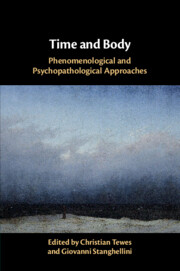Book contents
- Time and Body
- Endorsements for Time and Body
- Time and Body
- Copyright page
- Dedication
- Additional material
- Contents
- Figures
- Contributors
- 1 Introduction – Time and Body
- 2 Time, the Body, and the Other in Phenomenology and Psychopathology
- Part I Body and Time: General Aspects
- 3 The Body – Another
- 3.1 Commentary on “The Body – Another: Phenomenological and Psychoanalytic Perspectives”
- 4 The Heart of Darkness of the Living Body
- 4.1 Commentary on “The Heart of Darkness of the Living Body”
- 5 Microphenomenology of Chronicity in Psychosomatic Diseases
- 5.1 Commentary on “Microphenomenology of Chronicity in Psychosomatic Diseases: Diabetes, Anorexia, and Schizophrenia”
- 6 Time and Embodiment in the Process of Psychotherapy: A Dynamical Systems Perspective
- 6.1 Commentary on “Time and Embodiment in the Process of Psychotherapy: A Dynamical Systems Perspective”The Musicality of Human Interaction
- Part II Grief and Anxiety
- Part III Borderline Personality and Eating Disorders
- Part IV Depression, Schizophrenia, and Dementia
- Index
- References
5.1 - Commentary on “Microphenomenology of Chronicity in Psychosomatic Diseases: Diabetes, Anorexia, and Schizophrenia”
Chronicity as Stigma
from Part I - Body and Time: General Aspects
Published online by Cambridge University Press: 30 October 2020
- Time and Body
- Endorsements for Time and Body
- Time and Body
- Copyright page
- Dedication
- Additional material
- Contents
- Figures
- Contributors
- 1 Introduction – Time and Body
- 2 Time, the Body, and the Other in Phenomenology and Psychopathology
- Part I Body and Time: General Aspects
- 3 The Body – Another
- 3.1 Commentary on “The Body – Another: Phenomenological and Psychoanalytic Perspectives”
- 4 The Heart of Darkness of the Living Body
- 4.1 Commentary on “The Heart of Darkness of the Living Body”
- 5 Microphenomenology of Chronicity in Psychosomatic Diseases
- 5.1 Commentary on “Microphenomenology of Chronicity in Psychosomatic Diseases: Diabetes, Anorexia, and Schizophrenia”
- 6 Time and Embodiment in the Process of Psychotherapy: A Dynamical Systems Perspective
- 6.1 Commentary on “Time and Embodiment in the Process of Psychotherapy: A Dynamical Systems Perspective”The Musicality of Human Interaction
- Part II Grief and Anxiety
- Part III Borderline Personality and Eating Disorders
- Part IV Depression, Schizophrenia, and Dementia
- Index
- References
Summary
In her article, “Microphenomenology of Chronicity in Psychosomatic Diseases: Diabetes, Anorexia, and Schizophrenia,” the renowned French phenomenologist Natalie Depraz reflects upon chronicity as a category that might be common to different forms of chronic diseases. In my comment I will first summarize Depraz's analysis, which will then allow me to elaborate on some open questions that her chapter seems to leave us with.
- Type
- Chapter
- Information
- Time and BodyPhenomenological and Psychopathological Approaches, pp. 98 - 103Publisher: Cambridge University PressPrint publication year: 2020



